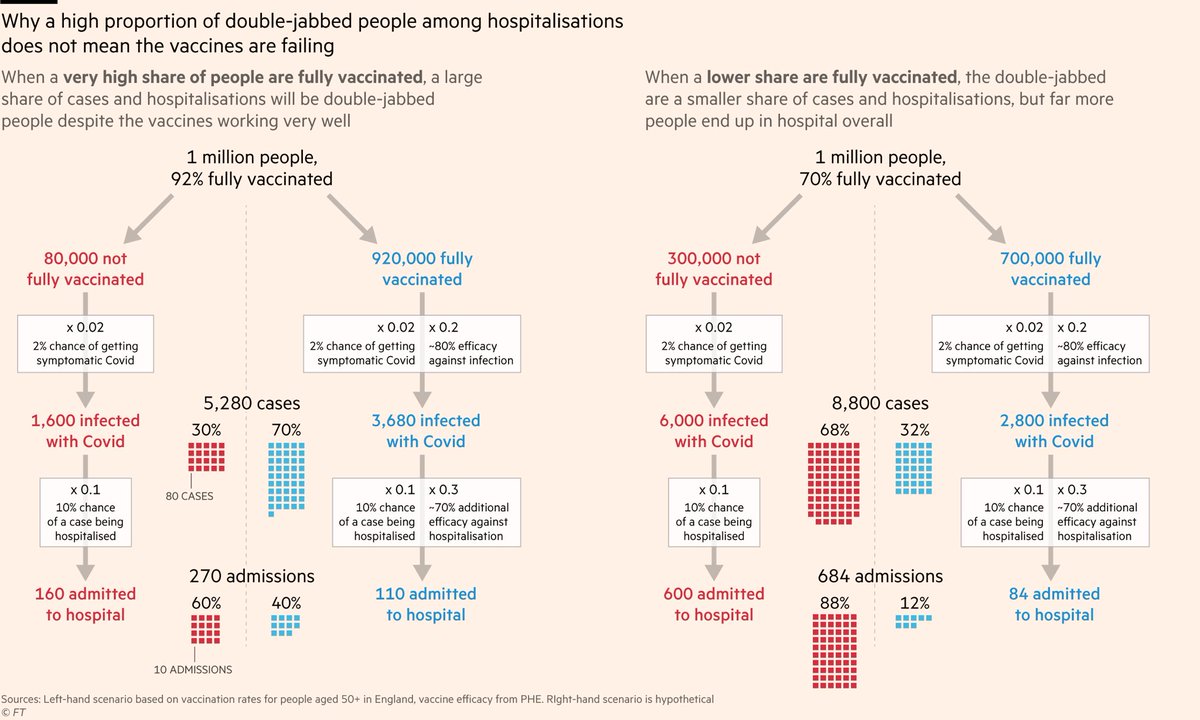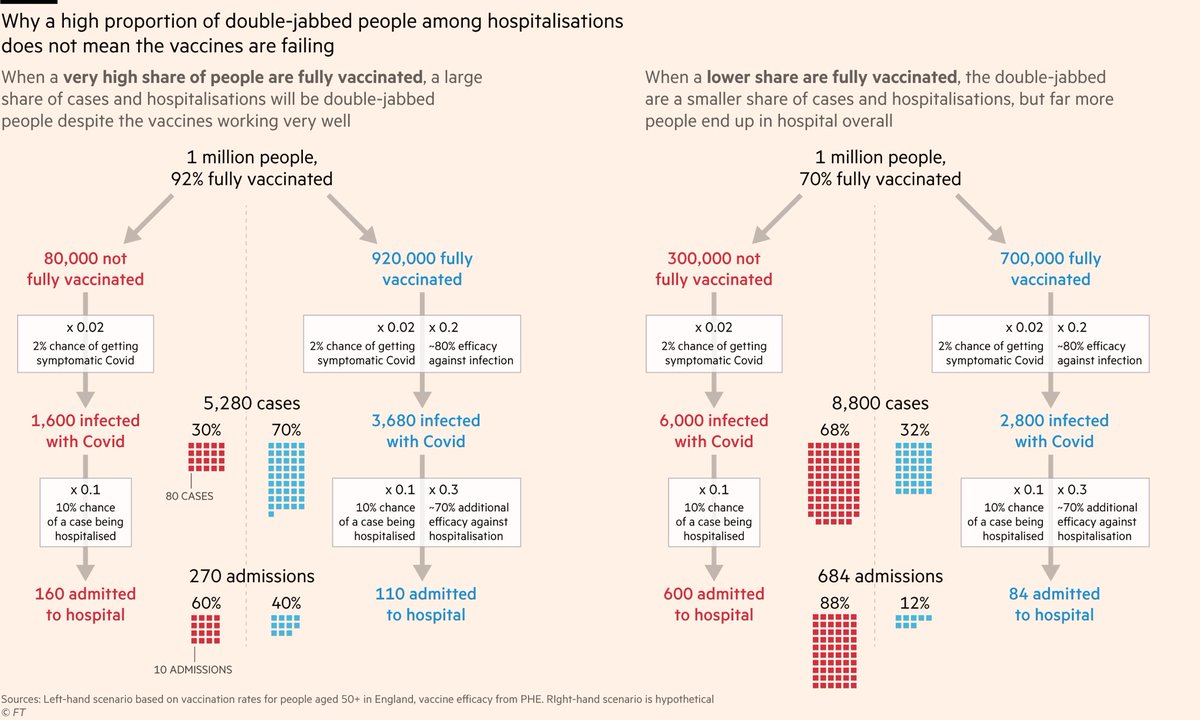There will be new cases, some of them severe and some leading ultimately to death. And there of course complications beyond death—even beyond hospitalization and severe disease.
If vaccination rates got close to 100%, we might be able to bring those numbers, in the future, close to zero. But even now we have probably eliminated 90% of all potential mortality from COVID-19. This makes it a very different kind of disease than we encountered last year.
First, "they kids are safe. Believe it or not, they always have been."
"It may sound strange, given a year of panic over school closures and reopenings, a year of masking toddlers and closing playgrounds and huddling in pandemic pods, that among children the mortality risk from COVID-19 is actually lower than from the flu."
"The risk of severe disease or hospitalization is about the same."
"This is true for the much-worried-over Delta variant. It is also true for all other variants. Most remarkably, it has been known to be true since the very earliest days of the pandemic—indeed it was among the very first things we did know about the disease."
"The preliminary mortality data from China was very clear: To children, COVID-19 represented only a vanishingly tiny threat of death, hospitalization, or severe disease."
"Over the course of the pandemic, 49,000 Americans under the age of 18 have died of all causes, according to the CDC. Only 331 of those deaths have been from COVID — less than half as many as have died of pneumonia."
"Some of these comparisons aren’t so neat, since the extraordinary precautions against COVID-19 prevented significant additional spread (and also suppressed the spread of other diseases)."
"But all told, 600,000 Americans have lost their lives to COVID over the course of the pandemic; just 0.05 percent of those were under the age of 18, a population that represents more than 20 percent of the country’s population as a whole."
"Risk is a tricky thing, the spread of the Delta variant and the complications of 'long COVID' both real concerns, and all parents should assess their own comfort, and those of their children, in making plans and taking precautions."
"But very few of them, two summers ago, were sending their children to parks and pools and camps in masks out of fear of pneumonia or flu. Probably fewer were keeping them home entirely."
"This summer, the calculations are very different than they were even last year, when the virus was still spreading wildly in an entirely unvaccinated population."
"That’s because, in the depths of a pandemic as we were then, individuals are not just individuals but links in a chain of transmission, which is the main reason why, for much of the last 18 months, public-health officials have worried over infections in the young..."
"...assuming they would eventually help bring the disease back to those much more vulnerable."
"But on that point mass vaccination in the U.S. has utterly changed the landscape of the pandemic: not only by protecting those who got shots, but by changing the calculus for all those who haven’t, by eliminating almost all of the mortality risk of the population as a whole."
"Vaccines have been, in this way, a double gift, at least to the corners of the wealthy world where vaccination has been widespread. The first gift is the most obvious one, the power of conferred immunity, whose strength and durability continues to impress."
"But the second gift may be more profound: the way our collective vulnerability has been transformed by vaccination programs focused on the old."
"The scale of this impact reflects the still under-appreciated fact of the age skew of COVID-19—even by those who know, vaguely, the older are more vulnerable. How much more? Per the CDC, the mortality risk for those 85 and above is 610 times higher than for 18-29 year olds."
"The number is so large it is almost hard to process. If a given number of infections among 20-somethings would produce just a single fatality, the same number of infections in 85-year-olds would produce 610."
"Of all the risk factors and comorbidities we read and heard so much about last spring, from race and class to obesity and COPD, each of which should raise ringing alarm bells about inequities in our society and our health system, the effect of age absolutely dwarfs all of them."
"And though the skew is most visible among the very old, the effect is consistent across all age groups, with mortality risk doubling every five years. This means every difference of two decades multiplies risk 16-fold. Three decades and the difference is 64-fold."
"Those aged 75-84 face a mortality risk from the disease 230 times higher than those in their twenties. Between 65 and 74 you are 95 times more likely to die from a COVID infection than the CDC’s 20-something baseline reference group."
"And the risk of children is dramatically smaller still than that CDC baseline; according to one, much-cited paper, the infection fatality rate for those aged 5 to 9 is less than 0.001 percent, about one-tenth the risk of flu for that age group."
"This suggests that a child of that age, even sick, faces roughly one-ten-thousandth the mortality risk of an 85-year-old."
"Statistically speaking, if a kid who comes down with a coronavirus infection is facing a threat to her life equivalent to the flu — perhaps less — a 90-year-old who does so is treading in the neighborhood of anthrax, the bubonic plague, and certain lighter outbreaks of Ebola."
"It was often said, in lamentations of American indifference at the outset of the pandemic, that the country would have taken the disease much more seriously if it hadn’t spared the very young. In the year that followed, we mostly pretended it didn’t."
"A large new study from the U.K. examining the fatality rate among all those under 18 found it only fractionally higher there—0.005%. But the fatality rate for RSV in healthy children, in contrast, is estimated to fall between 0.5% and 1.7%—at least 100 times higher."
"RSV is never, and would never be, as prevalent as the coronavirus has been this year, of course, which makes the comparison an imperfect one. But overall, 126,000 Brits have died of COVID since the onset of the pandemic; just 26 of those were under the age of 18."
"Death is not the only scary outcome of COVID-19 infection, of course, and hospitalizations don’t skew as dramatically as mortality. But an 85-year-old is still 15 times likelier to be hospitalized from COVID than a 20-something, who is many times more likely than a child."
"The WHO doesn’t even recommend universal mask-wearing for kids younger than 12."
"None of this is new, and, scientifically, none of it was ever disputed, not even during the bitterest and most intense of last year’s fights over pandemic policy."
"What scientists were debating instead was transmission rates — whether children could catch the disease, or spread it, as readily as adults, especially in the classroom settings that became the focal point of the fight."
"Studies on these questions have returned a variety of divergent answers, a sign of how complicated it can be to unpack the effects of one variable (like in-classroom learning) from others (local mask-wearing, seroprevalence, rates of social mixing versus social distancing)."
"But one recent eye-opening report was recently highlighted in Nature. Among 900,000 in-school pupils learning in North Carolina last fall, researchers would have expected, based on local transmission rates, about 900 cases of COVID. There were, it turned out, only 23."
"In another study, among 20,000 Nebraska students attending school all year there were, in total, two cases."
"There are other studies showing much more concerning rates. But even if the numbers are higher, the risk would not have been borne by the kids themselves, but their grandparents and other more vulnerable members of the community—of whom there are many fewer now."
"What about the unvaccinated elderly? In truth, there are very few places in the U.S. with many of them—that's what it means to have a national vaccination rate of 90% for seniors. No state has administered at least one shot of vaccine to less than 76% of its over-65 population."
"Though there are some counties with rates of elderly vaccination below 50 percent, there aren’t too many. At the state level, all but three states have reached 80 percent of their elderly population, and three states (Hawaii, Pennsylvania, and Vermont) have passed 99 percent."
"It would be better, of course, if every state were at that level — and if every senior who’d gotten one shot went ahead and got a second."
"But for all the anxiety about vaccination rates in the country as a whole (only 47% of the population has been fully vaccinated) and particular pockets of vaccine resistance (in Mississippi, it's 36%), almost everywhere you look the most vulnerable populations are well-covered."
"Hanging over all of this is the cloud of long COVID, but precisely how large a cloud — and how darkly it shadows over children in particular — remains very much an open question."
"The prospect of enduring, sometimes debilitating sickness is, of course, a legitimate concern, for individuals of any age, not just kids."
"But the reporting has often been anecdotal and studies aiming to document its prevalence have often been so filled with methodological problems — small sample sizes, self-reporting, no non-COVID comparison groups — it’s not easy to know which results to trust."
"In the U.S., Peter Hotez of Baylor has warned that low mortality rates among children are misleading because severe initial illness might be just the 'tip of the iceberg' of the country’s long-term coronavirus problem."
https://t.co/Ez3VytX5Xe
"Certain surveys have shown some alarming numbers..."
https://t.co/OkSUjugCfA
"But those finding long COVID in roughly a third or even half of the infected are almost certainly overestimates, and those suggesting 10 percent may well be, too..."
https://t.co/7YSi8iwOx2
"...since some of the symptoms being counted show up at the same rates among those who never got COVID."
https://t.co/zoUCOYVfUm
"One large, much-referred-to survey in the U.K. found that between 7 and 9 percent of children who got sick were suffering from at least one symptom some months on..."
https://t.co/0CnylWCEXX
"...though the same survey also suggested the relative burden of long COVID in children was much smaller than in adults—of about one million people in the country complaining of long-term symptoms, only 3%, or 33,000, were kids, who make up more than a fifth of the population."
"Another, perhaps more rigorous recent study in pre-print, looking at NHS data in the U.K., found that among more than one million patients diagnosed with COVID, only 3,000 registered long COVID — well under one percent."
https://t.co/UcPK8vOjgJ
"We don’t yet have anything like that scale of study for American kids, but a subset of long-COVID research linking the severity of disease to the likelihood of enduring symptoms implies that the risk may be considerably smaller in children than in the population at large."
"All of this suggests that, given American vaccination rates and the age skew of the disease, we might stop worrying so much about cases—stop treating them as a proxy for the severity of the pandemic, and stop believing they tell us something obvious about near-future deaths."
"In countries like this one, with mass vaccination of the elderly already behind us, we could track the course of the disease instead through hospitalizations or deaths, which now have a very different relationship to case numbers than they did a year ago."
"When we built our mental models of the pandemic last spring and summer, a certain number of new cases told us one kind of story, and we learned to extrapolate from a certain rising rate of case growth an inevitable rise in death rates a few weeks later."
"But we are living in a very different world now, in which both the lion’s share of mortality risk has been eliminated through vaccination targeted at the elderly, and in which a much larger share of the ongoing transmission of the disease is producing much milder cases."
"In the rest of the world, where vaccination rates are much lower and the elderly remain very much at risk, of course, the pandemic looks much more like it did a year ago, indeed even scarier given how much more transmissible Delta is."
"This is another reason, if we needed one, to be outraged at the geopolitics of vaccines: protecting the vulnerable in those countries could be done efficiently, too."
"Many countries in the developing world don’t need 80% of their populations vaccinated to eliminate the lion’s share of their own mortality risk, but just a fraction of that—often, due to the age structure of those populations, a much smaller fraction than was required here."
"In parts of Europe where the vaccination rates remain low, near-vertical rates of case growth, driven by Delta, remain concerning; case growth elsewhere in the world, likely more so."
"But in the well-vaccinated U.K., where the rise of the Delta variant has generated widespread anxiety about a national 'reopening' scheduled for July 19, the ratio of case growth to hospitalization rates has fallen more than fivefold."
https://t.co/KYSQtHnQuS
"The infection fatality rate has fallen perhaps 20-fold."
https://t.co/pvBm8HYo97
"Even focusing just on Delta, the fall has been at least tenfold: to 0.2 percent compared with 1.9 percent for the original, 'Alpha' strain."
https://t.co/lOqr77w0cp
"Which helps explain why, even amidst flatlining vaccination rates and rapid spread of Delta, there are now those, like
@AmeshAA of Johns Hopkins, taking the opportunity to mark 'the end of the acute phase of the public health emergency in this country.'"
https://t.co/6iXcMB9hVM
"And why others, like
@MonicaGandhi9 of the University of California, San Francisco, suggesting, reasonably, we might think about downgrading from 'epidemic' to 'endemic.'"
https://t.co/2KqHt8FPpC
"In the U.K., even the University of Edinburgh’s
@devisridhar, long the country’s most vocal advocate for a no-tolerance, total-suppression approach known as 'zero COVID,' has lately been wondering, 'Can we now live with the coronavirus?'"
https://t.co/u4Y8fOpw2B
@devisridhar It's not a perfect conclusion to the pandemic, and the disease hasn't been eliminated. But thanks to the vaccines, in the U.S. at least I think the answer to that question is finally, mercifully, "yes." (X/x)































